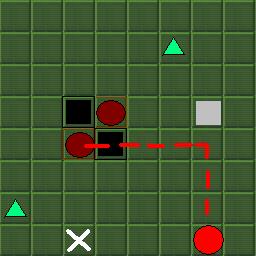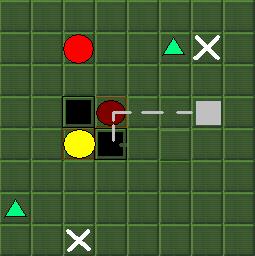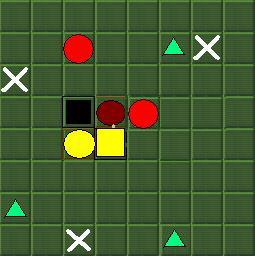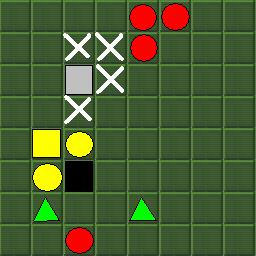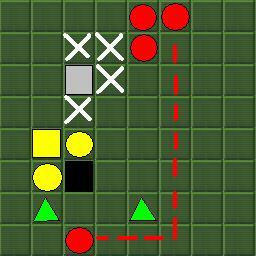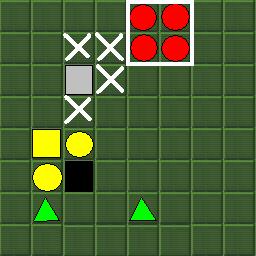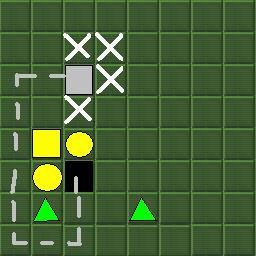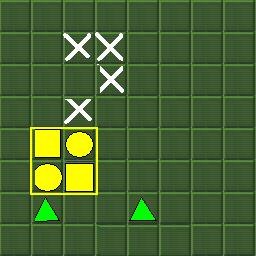GCPP:Proposal-Kali
Puzzle Codename: Kali
| Contact | |
| Username: | al_zahrah |
| Additional contact info: | elengil_v@yahoo.com |
| Project forum thread: | Kali Discussion Thread |
Game concept
a similar construct to games like atomica with an element of 'sailing'
Objective
to clear targets from a board by moving patterns of matching pieces over the target
Gameplay
A playing board representing a table top divided into a grid of playing squares. Random 'targets' of four or six squares are generated that represent goals to accomplish. Starting 'pieces' of four kinds are also generated in random locations on the board. The four game pieces/target square patterns represent Cutting, Shaping, Sanding, and Polishing
The player must move a game piece to a corresponding goal square by matching the pattern on the square to the pattern on the game piece. When all goal squares are filled with the correct game piece, the target and pieces are removed from the board. When a game piece is on the correct square of a target, the piece turns gold and is 'locked' in . It can be moved, but can not be cleared in a group of 4/6 like pieces or cleared with a special move. Excess pieces can be removed from the board by forming squares of 4 or rectangles of 6 of the same pattern.
In order to move the piece to the target or destination square, there must be a clear path to follow from beginning to end on the board. If the destination is completely cut off from the game piece by other pieces or blocks, then a path must be cleared before the piece can be moved.
Each move a player makes generates a new number of random game pieces on the grid unless the move completes a target or set of four, in which case the player can make another free move until a move is made that does not complete a target or set.
Game play ends when no more moves can be made or all targets are completed.
Scoring
scoring is based on the number of targets completed and the overall number or moves used. Bonuses for completing chains of multiple targets or multiple groups of 4/6.
Variability
blocks or "knots" that can not be moved, but can be removed by using them to form a group of 4 or 6. 'embelishment' pieces that act as random cards and can be used in any target square or group. If a single chain of completed targets or groups reaches a pre-defined score, the player gets a special move of clearing a number of pieces randomly (not chosen by the player), excepting those locked into a target square.
End criteria
when a player has cleared all the targets, (number of targets and target squares changes with difficulty), or can no longer move on the board.
Difficulty scaling
more targets to be cleared or targets with more squares. pieces generate more per round. more "knot" blocks to inhibit game piece movement.
Crafting type
Furnishing. Framework could be used for tailoring.
Known problems
none?
Notes
Images
A starting board might look like this, with a target (the brown circles/black squares block) and randomly placed game pieces:
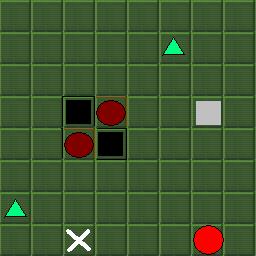
A possible first move would be to take the circle game piece and move it to the corresponding circle target square. New game pieces are then randomly generated on the board and the next move can be made, taking the square and moving it to the square target, and new pieces are generated.
A board might look like this after several moves, and set-up for a multiple move chain.
The square can not be moved to complete the target because of the other pieces blocking it. Therefore, if the circle is moved, it will complete a block of 4 and the block will be removed from the board. You have a free move with no new game pieces being added, and the square can now be moved to complete the target block.
While it may look like a triple combo is possible here, because moving the square allows the X to move to create another block of 4, it will not work because removing the last target block on the board means the game is over, and the X block is left unfinished. If another target was on the board, however, this would have been a perfect setup for a chain of 3.
